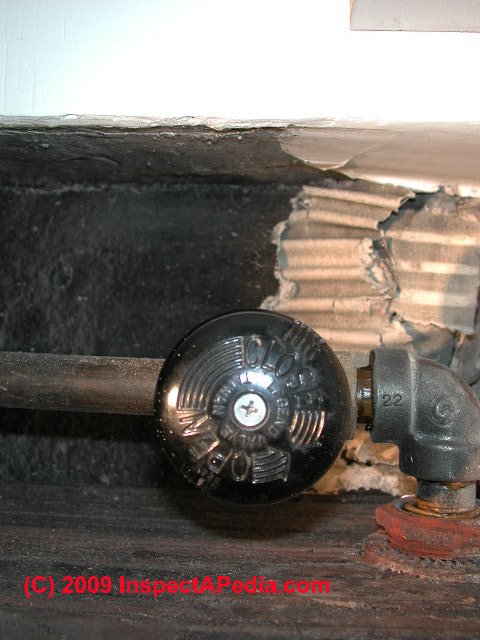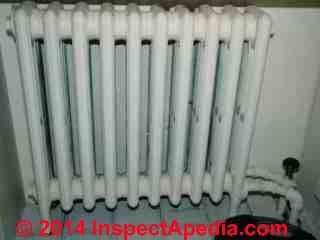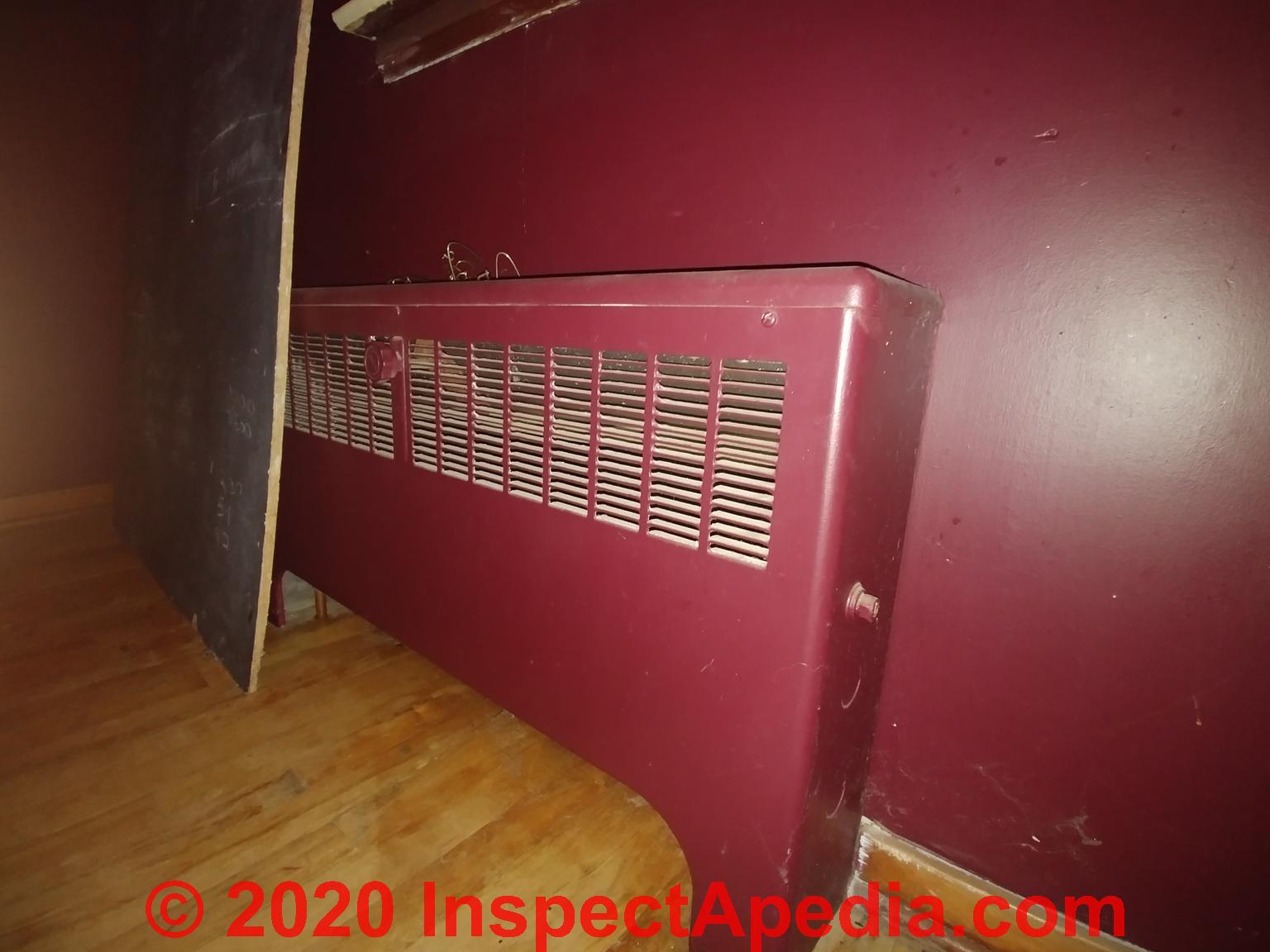 Radiator Valve Adjustment
Radiator Valve Adjustment
How to set the heating system output higher or lower
- POST a QUESTION or COMMENT about how to adjust the radiator valve to set the heating system output higher or lower
Radiator valve adjustment guide.
Here we explain the adjustment of hot water or steam heating radiator valves & steam vents to control heat output from individual radiators.
InspectAPedia tolerates no conflicts of interest. We have no relationship with advertisers, products, or services discussed at this website.
- Daniel Friedman, Publisher/Editor/Author - See WHO ARE WE?
How to Adjust or Control the Level of Heat From Radiators
Manually Set the Radiator Valve
On hot water heating systems and two-pipe steam radiator heating systems you can adjust the radiator valve to:
- Fully closed radiator valve
- no heat is wanted from that radiator, but
Watch out: if you completely turn off heat to a hot water radiator in an area exposed to freezing the radiator is likely to freeze, break, and be ruined. - Partly closed radiator valve
to call for less heat at an individual radiator - this setting can be used for both hot water heat and for two-pipe steam heat systems.
- Fully open radiator valve
- to call for as much heat as possible from the radiator. For one pipe steam heat systems, if you want heat, use this position.
If your hot water radiator is too hot
or the room is too hot, you can partially close the radiator valve.
If your hot water radiator is too cold,
be sure that the valve is open and that the radiator is not air bound.
Details are at COLD RADIATOR REPAIR
If your steam radiator is too cold
be sure that its supply valve is open. If it's a one pipe steam heat system (only one pipe comes to each radiator), be sure that the steam vent is working (you should hear it hissing when steam is rising in the system).
Details are at STEAM HEAT RADIATOR REPAIR.
If your steam radiator is too hot in a two-pipe steam system, according to the U.S. DOE,
In two-pipe systems, older steam traps often stick in either the open or closed position, throwing off the balance in the system.
If you seem to have problems with some radiators providing too much heat and others providing too little, this might be the cause. The best approach is often to simply replace all the steam traps in the system.
If your steam heating system pipes are noisy
see BANGING HEATING PIPES RADIATORS where we explain steam condensate return problems that can cause banging clanging pipes.
There are additional methods for automatically controlling the heat output from individual heating radiators, for both steam and hot water heat: thermostatically controlled radiator valves and adjustable or thermostatically controlled steam vents.
We discuss these controls beginning
at AUTOMATIC or Thermostatically Controlled Radiator Valves - TRVs.
How to turn off unwanted heat at a baseboard or radiator
My husband and I just bought a 1948 built house and we think it has all original heaters. 2 rooms have the stand up style cast iron radiators.
Our kitchen, dining, and bedroom have what we think are cast iron baseboard style heaters. They look a lot like, but are not exactly, the ones pictured here.
[Click to enlarge any image]
All of the above-mentioned rooms are all on the same heating zone. My question is, how do I shut off heat to only one of the rooms? I'd like to completely shut off the heat to my bedroom only. Can I safely do this without shutting off the heat to the other rooms?
How do I find the valve to shut this room off?
At this point the bedroom is our biggest waste of heat as we have to keep a window open in there to keep it from being insufferably hot, while the other rooms in that zone are still quite chilly. We have the thermostat set down to 50.
Please help! - 12/31/2014 Margaret said:
- Above: an example of cast-iron heating baseboard provided by Baseray and used for hot water or steam heating. This product is available from U.S. Boiler - see usboiler.net.
Reply: When comparing baseboards & radiators: which ones have shut-off valves?
You can shut off heat to individual heating radiators such as the cast iron radiator shown at left by closing the individual radiator valve or by installing a thermostatically operated radiator valve such as those we illustrate just below.
But your "radiators", if the photo you refer-to at above-left is correct, is a segment of cast iron baseboard. I know the terms are confusing but "baseboard" is generally a horizontal heating element placed (usually) close to the floor.
Three cases of heating baseboard section control
1. Heating baseboard sections piped in series in one loop
of hot water piping: In the most common heating baseboard design, one cannot close off an individual section of baseboard type "radiator" because it is piped in series with the rest of that heating zone.
Cutting off that baseboard by installing a shutoff valve would stop hot heating water from passing on to other baseboard sections in that zone. Instead you'd have to shut off all of the heat that shares that hot water piping loop.
If your baseboard heat was installed as an individual heating zone serving the rooms you name, it is probably operating as a heating zone, controlled by a thermostat and zone valve.
See ZONE VALVES, HEATING.
You'd have to have a plumber modify the heating system piping to create individual zones - technically possible but, depending on the ease of access to piping below the rooms involved, possibly rather expensive.
2. Heating baseboard installed to replace older radiators:
If the cast iron baseboard heating sections were added to replace older stand-up radiators such as the heating device we show at left, then possibly the piping included a shut-off valve at the inlet end of the baseboard section or in the basement or ceiling below that location.
3. Heating baseboards piped in parallel:
Rarely we find sections of heating baseboard piped in parallel. In that case individual sections of baseboard might have a shut-off valve installed at the inlet end of the baseboard. But as it's rare I doubt that you'll find a shut-off valve for your heating baseboard.
...
Reader Comments, Questions & Answers About The Article Above
Below you will find questions and answers previously posted on this page at its page bottom reader comment box.
Reader Q&A - also see RECOMMENDED ARTICLES & FAQs
Question: trouble controlling level of steam heat - can I close off the radiator
My building uses steam heaters. I have no control over the heat in my unit because the thermostat is controlled by my landlord/owner who lives above me.
This is an image of one them. The other side is smooth (nothing on or in it).
However I have a small 1 bedroom with two heating units so even with all of the windows open, it can still get very hot. Is it okay for me to completely close the "open/close" black knob valves on my units or will that cause problems for the whole system? My landlord had previously told me not to touch the valves... Emily 12/10/12
Reply:
Yes if the radiator control knob is not jammed or frozen you can try closing it partly or fully; radiator control knobs are intended to be a homeowner-resident-operator control. But if the knob is not easy to turn, don't force it as you might end up with a leak.
I have collected together our discussion of identifying the manual air bleeder on the side of your heating convector - now found at
RADIATOR VALVE & HEAT CONTROL FAQs - questions and answers posted originally on this page.
https://inspectapedia.com/heat/Radiator_Valve_FAQs.php
On 2020-10-13 by Matt - questions about thermostatic radiator valves TRVs & effect of closing one pipe steam radiator
2 Questions:
1) You mentioned that one pipe steam systems should be set to fully open or fully closed as having something partially open could damage the system. I'm assuming that's why in single pipe steam systems you're reliant on adjustable air vents to control the heat of the radiator.
Does that mean that the TRVs are only recommended for water or two pipe systems as the function of the TRV is to partially open or close the valve?
2) I have a one pipe steam radiator in a small area by the thermostat on the first floor that I'd like to completely shut off. I'm assuming it being on is influencing how hot the second floor is getting (not quite as warm as the first floor).
The valve won't budge in either direction. Should/Can I spray some WD-40 on the valve stem to see if that loosens things up? If not, do you have an article on replacing just the valve stem (if that's even possible)?
On 2020-10-13 - by (mod) - Which TRVs work on 1 pipe steam radiators?
Matt
It's certainly the case that some thermostatic radiator valves are described by the manufacturer as specifically for "hot water" i.e. hydronic not steam, heating systems.
E.g. The Danfoss ... TWA-actuator is used to electrically activate RA-2000, VMT, KOVM and RAV valves on hot water heating systems,
But there are other thermostatic radiator valves like the Honeywell Braukmann V2042 HSL 10 that are specifically designed for 1-pipe steam heating systems. Described as
"One-Pipe Steam Thermostatic Radiator Valves - Allow automatic temperature control in one-pipe steam or hot water systems for free standing radiators, convectors and other heating units with standard capacity requirements. Provide comfort and energy savings."
See these example instructions HONEYWELL BRAUKMANN V2040HSL10 INSTALLATION INSTRUCTIONS [PDF]
inspectapedia.com/heat/Honeywell-Braukmann-V2042HSL10-Manual.pdf
Conversely the Danfoss 013G8250 thermostatic radiator valve actuator is intended to work on hydronic or on two-pipe steam heating systems.
RA 2000 Thermostatic Radiator Valves regulate the flow of hot water or low pressure steam through free-standing radiators, baseboards, or convectors in hot water and two-pipe steam systems. The Danfoss 013G8250 is the RA2000 Thermostatic Radiator Valve Operator with a valve mounted dial and a built-in sensor.The RA 2000 thermostatic operator consists of a saturated vapor charged bellows and a setting dial. The dial is set to the position equal to the desired temperature. When the ambient temperature lowers, the pressure from the bellows will reduce, allowing the valve to open.
A rise of temperature increases the pressure in the bellows closing the valve. The balanced pressures between the adjustment spring and the bellows ensure a smooth and modulating operation of the valve.
See these DANFOSS RA2000 RADIATOR VALVE INSTALLATION INSTRUCTIONS [PDF]Thanks, that's an interesting question about which valves work on which radiators that I'd not adequately considered.
It's certainly the case that some thermostatic radiator valves are described by the manufacturer as specifically for "hot water" i.e. hydronic not steam, heating systems.
E.g. The Danfoss ... TWA-actuator is used to electrically activate RA-2000, VMT, KOVM and RAV valves on hot water heating systems,
But there are other thermostatic radiator valves like the Honeywell Braukmann V2042 HSL 10 that are specifically designed for 1-pipe steam heating systems. Described as
"One-Pipe Steam Thermostatic Radiator Valves - Allow automatic temperature control in one-pipe steam or hot water systems for free standing radiators, convectors and other heating units with standard capacity requirements. Provide comfort and energy savings."
See these example instructions HONEYWELL BRAUKMANN V2040HSL10 INSTALLATION INSTRUCTIONS [PDF]PS, if you close off the steam vent on that radiator that should ultimately prevent it from getting warm. That's an alternative to try to close the rad valve.
...
Continue reading at a href="https://inspectapedia.com/heat/Automatic-Radiator-Valves.php">AUTOMATIC RADIATOR VALVES or select a topic from the closely-related articles below, or see the complete ARTICLE INDEX.
Or see these
Recommended Articles
- AIR-BOUND HEATING SYSTEMS - home
- AIR BLEEDER VALVES - home - bleed air out of radiators that are not getting hot
- CHECK VALVES, HEATING SYSTEM - more hot water & steam heat controls
- RADIATOR VALVES & HEAT CONTROLS - find & identify
- AUTOMATIC RADIATOR VALVES - Automatic or Thermostatically Controlled Radiator Valves
- COLD HOT WATER RADIATOR or BASEBOARD - fix cold hot water heat (hydronic) radiators
- STEAM HEAT RADIATOR REPAIR - fix cold steam radiators
- RADIATOR CONTROL VALVES on CONVECTOR HEATERS
- RADIATOR VALVE ADJUSTMENT - How to Adjust or Control the Level of Heat From Radiators
- RADIATOR VALVES MANUAL - Which way to turn the radiator valve
- RADIATOR VALVE STUCK or BROKEN REPAIR - how to repair or replace radiator valves
- RADIATOR VALVE TYPES - hot water, steam, automatic? what's the difference?
- STEAM HEAT VENT CHOICES & INSTALLATION - Adjustable or Thermostatically Controlled
- STEAM VENTS THERMOSTATICALLY CONTROLLED - Used to control steam radiators
- STEAM RADIATOR PIPING CONNECTIONS
Suggested citation for this web page
RADIATOR VALVE ADJUSTMENT at InspectApedia.com - online encyclopedia of building & environmental inspection, testing, diagnosis, repair, & problem prevention advice.
Or see this
INDEX to RELATED ARTICLES: ARTICLE INDEX to HEATING RADIATORS
Or use the SEARCH BOX found below to Ask a Question or Search InspectApedia
Ask a Question or Search InspectApedia
Questions & answers or comments about using, adjusting, & repairing radiator control valves and vents for both hot water and steam heat systems
Try the search box just below, or if you prefer, post a question or comment in the Comments box below and we will respond promptly.
Search the InspectApedia website
Note: appearance of your Comment below may be delayed: if your comment contains an image, photograph, web link, or text that looks to the software as if it might be a web link, your posting will appear after it has been approved by a moderator. Apologies for the delay.
Only one image can be added per comment but you can post as many comments, and therefore images, as you like.
You will not receive a notification when a response to your question has been posted.
Please bookmark this page to make it easy for you to check back for our response.
IF above you see "Comment Form is loading comments..." then COMMENT BOX - countable.ca / bawkbox.com IS NOT WORKING.
In any case you are welcome to send an email directly to us at InspectApedia.com at editor@inspectApedia.com
We'll reply to you directly. Please help us help you by noting, in your email, the URL of the InspectApedia page where you wanted to comment.
Citations & References
In addition to any citations in the article above, a full list is available on request.
- [1] Dan Holihan, "Your Most Frequently Asked Questions About Cast-Iron Radiators – Answered! by Dan Holohan", http://www.oiltechtalk.com/pages/cast_iron.htm, retrieved 3/7/2013.
- Barnes & Jones Corporation, 91 Pacella Park Drive Randolph, MA 02368, Tel: 781-963-8000calibrated steam traps and vents, Email: bnesbitt@barnesandjones.com. Vent-Rite steam vents for radiator control.
- Gorton Heating Corporation, 546 South Avenue East, Cranford, New Jersey 07016, Tel: 908-276-1323, email: info@gorton-valves.com, fast venting valves for steam heating systems.
- Armstrong, Rv-4 One-Pipe Steam Radiator Valve [PDF] available from Armstrong International,
816 Maple Street, Three Rivers, MI 49093 USA, Tel: (269) 273-1415, Armstrong has offices in Beijing, China, Belgium, India and Mexico. Web search 12/27/2010, original source:
http://www.armstronginternational.com/thermostatic-valves-rv-4-one-pipe. - [6] "Special Steam Vents", Hoffman Specialty heating products, web search 12/27/2010, original source:
http://www.hoffmanspecialty.com/pdf/hs900/HS900-3474.pdf - Hoffman Convector Steam Vents [PDF] available from Hoffman Specialty, ITT, web search 12/28/2010, original source: http://www.hoffmanspecialty.com/pdf/hs900/HS900-conv109.pdf
- [10] Report 95-14, PB96-198163 Thermostatic Radiator Valve (TRV) Demonstration Project, contact NYSERDA. 17 Columbia Circle, Albany, NY 12203-6399 Toll-Free: 1-866-NYSERDA, Tel:(518)465-6252, Ext. 241. Web Search 12/27/2010, original source: http://www.homeenergy.org/archive/hem.dis.anl.gov/eehem/96/960509.html
- [21] Thanks to reader Paul Ruud for discussing improved steam heat controls and thermostatically operated steam radiator valves and air vents, 12/27/2010.
- "Residential Hydronic (circulating hot water) Heating Systems", Instructional Technologies Institute, Inc., 145 "D" Grassy Plain St., Bethel, CT 06801 800/227-1663 [home inspection training material] 1987
- In addition to citations & references found in this article, see the research citations given at the end of the related articles found at our suggested
CONTINUE READING or RECOMMENDED ARTICLES.
- Carson, Dunlop & Associates Ltd., 120 Carlton Street Suite 407, Toronto ON M5A 4K2. Tel: (416) 964-9415 1-800-268-7070 Email: info@carsondunlop.com. Alan Carson is a past president of ASHI, the American Society of Home Inspectors.
Thanks to Alan Carson and Bob Dunlop, for permission for InspectAPedia to use text excerpts from The HOME REFERENCE BOOK - the Encyclopedia of Homes and to use illustrations from The ILLUSTRATED HOME .
Carson Dunlop Associates provides extensive home inspection education and report writing material. In gratitude we provide links to tsome Carson Dunlop Associates products and services.




